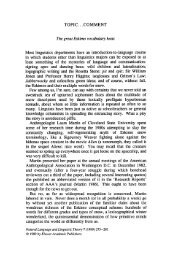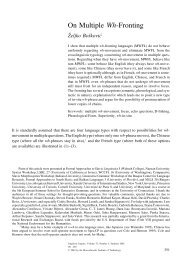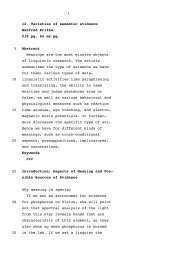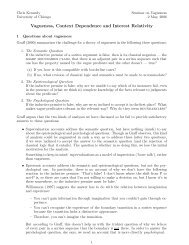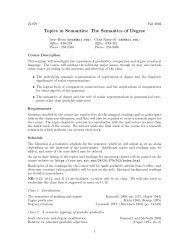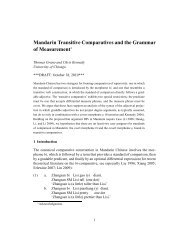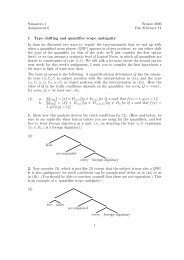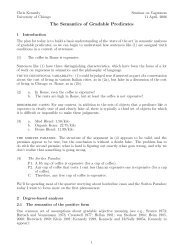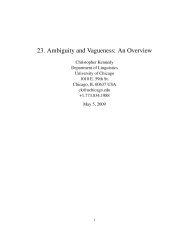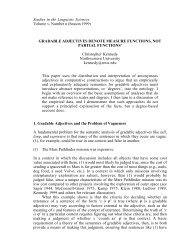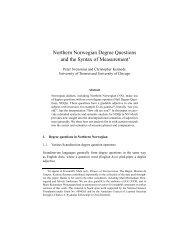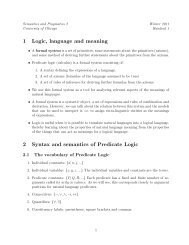On the natural history of negative polarity items - Syntax, Semantics ...
On the natural history of negative polarity items - Syntax, Semantics ...
On the natural history of negative polarity items - Syntax, Semantics ...
You also want an ePaper? Increase the reach of your titles
YUMPU automatically turns print PDFs into web optimized ePapers that Google loves.
Ka<strong>the</strong>rine McKinney-Bock & Roumyana Pancheva<br />
that is in complementary distribution with ano<strong>the</strong>r type <strong>of</strong> head, DEG, whose presence is marked<br />
by <strong>the</strong> silent for-phrase: (8) [[DEG for a man] big]<br />
(9) ⟦DEG⟧ = !P . !G. !D. !x: P(x). !D" [G(D")(x) " D" # D " D # S(P,c)(G) ]<br />
⟦for a house⟧ = !x. x is a house ⟦big⟧ = !D. !x. x’s size # D<br />
Evidence for this constituent structure comes from <strong>the</strong> observation that, in addition to forphrases,<br />
as in (10), modification by measure phrases, as in ) John is tall for a man. (11), is<br />
permissible. However, <strong>the</strong>se two types <strong>of</strong> adjective modification cannot co-occur, (11):<br />
(10) John is tall for a man. (11) John is six feet tall. (12) *John is six feet tall for a<br />
man.<br />
Now, when looking at plural nouns such as those in (1) and (2), <strong>the</strong> for-phrase takes a noun<br />
which sets <strong>the</strong> comparison class and derives <strong>the</strong> effect seen with GAA. More specifically, we<br />
propose that <strong>the</strong> adjective merges underneath <strong>the</strong> plural phrase (#P, cf. Borer 2005), and so, <strong>the</strong><br />
identity condition on ellipsis resolution dictates that <strong>the</strong> silent noun in <strong>the</strong> for-phrase is not<br />
structurally specified for number. Then, if a plural phrase merges higher, we can obtain <strong>the</strong> plural<br />
noun. The structure is as follows:<br />
(13) [PluralP Plural [NP [AP [DEG for a box] heavy] box ]]<br />
We fur<strong>the</strong>r observe that higher syntactic placement <strong>of</strong> <strong>the</strong> attributive adjective results in <strong>the</strong><br />
return <strong>of</strong> <strong>the</strong> collective/distributive ambiguity (Ouwayda 2011).<br />
(14) The heavy twelve boxes ! distributive; ! collective<br />
<strong>On</strong> <strong>the</strong> collective reading, (13) does not meet <strong>the</strong> non-monotonicity requirement, which fits<br />
better <strong>the</strong> view that this requirement is a consequence <strong>of</strong> <strong>the</strong> specific syntax and semantics <strong>of</strong><br />
attributive modification ra<strong>the</strong>r than a constraint that rules out an o<strong>the</strong>rwise potentially available<br />
reading. To account for <strong>the</strong> return <strong>of</strong> collective readings with higher placement <strong>of</strong> <strong>the</strong> attributive<br />
adjective (cf. (3)), we propose that [[DEG [for N]] heavy] moves above <strong>the</strong> plural phrase, and <strong>the</strong><br />
noun is elided under identity with ei<strong>the</strong>r a type noun (not specified for number) or a noun<br />
specified for number. Ellipsis <strong>of</strong> <strong>the</strong> plural noun in <strong>the</strong> for-phrase is licensed based on <strong>the</strong><br />
assumption that <strong>the</strong> antecedent should not contain <strong>the</strong> ellipsis site, and so [DEG for boxes heavy]<br />
moves outside <strong>of</strong> <strong>the</strong> Plural head. Attachment outside <strong>of</strong> <strong>the</strong> Plural operator allows for <strong>the</strong><br />
collective reading (see 14), and attachment inside <strong>of</strong> <strong>the</strong> Plural operator allows for <strong>the</strong><br />
distributive reading (as in 13).<br />
(15) [[AP [DEG for boxes] heavy] [PluralP Plural [NP box ]]<br />
Evaluative adjectives like pretty similarly do not fit <strong>the</strong> view that non-monotonicity derives <strong>the</strong><br />
requisite distributivity. In (15), a collective reading <strong>of</strong> pretty would meet <strong>the</strong> non-monotonicity<br />
requirement and yet such a reading is not allowed:<br />
(16) Context: ugly pieces <strong>of</strong> gravel come toge<strong>the</strong>r to form a beautiful mosaic<br />
#The pretty rocks formed a mosaic.<br />
We propose that <strong>the</strong> requisite distributive reading with attributive adjectives stems independently<br />
<strong>of</strong> non-monotonicity, derived from <strong>the</strong> presence/absence <strong>of</strong> a for-phrase, as above, and that nonmonotonicity<br />
<strong>of</strong> is a consequence <strong>of</strong> distributivity.<br />
References: Bale, A. 2008. Count Nouns, Mass Nouns, Plurality and Measure Phrases. U. <strong>of</strong><br />
Pennsylvania. Kennedy, C. & L. McNally. 2005. Scale structure, degree modification, and <strong>the</strong><br />
semantics <strong>of</strong> gradable predicates. Language. Kennedy, C. 2007. Vagueness and grammar: <strong>the</strong><br />
semantics <strong>of</strong> relative and absolute gradable adjectives. L&P. Ouwayda, S. 2011. Cardinals,<br />
agreement and plurality in Lebanese Arabic. Sinn und Bedeutung 16. Schwarz, B. 2010. A Note<br />
on for-phrases and derived scales. Sinn und Bedeutung 15. Schwarzschild, R. 2009. Stubborn<br />
Distributivity, Multiparticipant Nouns and <strong>the</strong> Count/Mass Distinction. NELS 39.



